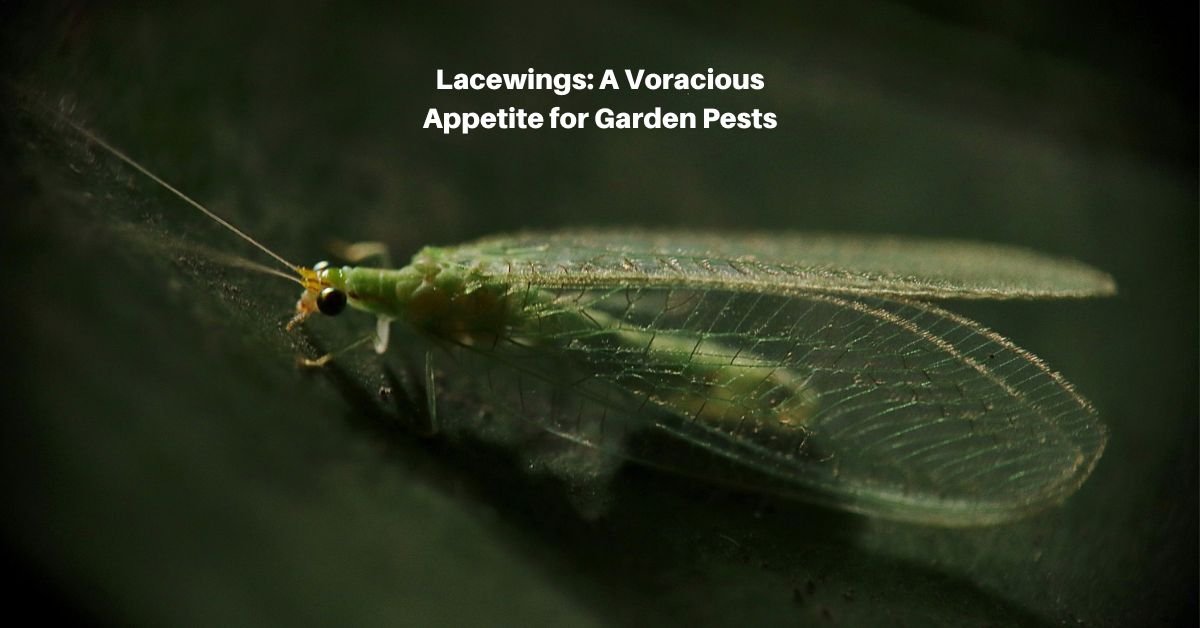Battling garden pests calls for many weapons. Sometimes, that may mean chemicals, but it’s always best to seek or take advantage of more natural means. The presence of lacewings in your garden offers a beacon of hope and a testament to nature’s ingenuity.
These insects, with their delicate wings and voracious appetites for common garden pests, embody the principles of ecological balance and sustainable pest management. Recognizing and fostering lacewings in the garden contributes to a healthier environment and supports the broader ecosystem that our gardens are a part of.
Identification and Lifecycle of Lacewings
Lacewings are easily identified by their bright, metallic eyes and translucent, lace-like wings spanning up to 1.5 inches. Two common types grace our gardens: the green lacewing, known for its pale green body and golden eyes, and the brown lacewing, which, as the name suggests, has a brown hue.
The lifecycle of a lacewing unfolds in four stages: egg, larva, pupa, and adult. Lacewing eggs often hang from plants on slender stalks; a strategy evolved to protect them from predators and sibling cannibalism.
The larval stage lasts about 2-3 weeks. During this period, they are voracious predators, consuming many pests. Following a pupal stage, where they metamorphose within a cocoon attached to foliage, they emerge as adults, ready to mate and continue the cycle.
Overall, a lacewing takes about 27 days to grow from an egg to an adult. As adults, they live another 20 to 40 days. The females can lay eggs every night, usually between 10 to 30 eggs in each batch.
The Diet of Lacewings: Natural Pest Controllers
Lacewing larvae are nature’s pest control agents, preying on various garden pests. Their diet includes aphids, mites, caterpillar eggs, thrips, and whiteflies. A single lacewing larva can devour up to 200 aphids or other prey per week. This appetite makes the lacewing an invaluable ally in managing garden pest populations.
Adult lacewings, in contrast, feed primarily on nectar, pollen, and honeydew.
Benefits of Lacewings in the Garden
The introduction or natural attraction of lacewings into the garden brings a multitude of benefits:
- Reduction of Pest Populations: Lacewings help keep pest numbers in check, reducing the need for chemical pesticides and fostering a more natural garden environment.
- Promotion of Plant Health: Lacewings indirectly promote healthier, more vigorous plant growth and productivity by controlling pests that damage plants.
- Contribution to Biodiversity: Supporting lacewings encourages garden biodiversity, which enhances ecosystem resilience and stability.
Attracting Lacewings to Your Garden
Creating a lacewing-friendly garden involves a few key strategies that encourage these beneficial insects to visit and stay:
- Plant Diversity: Incorporating a variety of flowering plants, especially those with small flowers like dill, coriander, and alyssum, provides adult lacewings with the nectar and pollen they need.
- Reducing Pesticide Use: Minimizing or eliminating broad-spectrum pesticides protects lacewings and other beneficial insects, allowing natural pest control mechanisms to flourish.
- Providing Habitat: Leaving some garden areas a little wild can offer lacewings and other beneficial creatures safe places to lay eggs, overwinter, and hide from predators.
Encouraging lacewings in the garden can be a huge part of sustainable and eco-friendly practices. By understanding and supporting these insects’ lifecycle and dietary needs, gardeners can harness their natural pest control capabilities, contributing to a balanced and healthy garden ecosystem.
Integrating Lacewings into Pest Management Strategies
Adopting lacewings into your garden’s pest management plan can be part of a holistic approach that emphasizes the health of the entire garden ecosystem. These delicate winged creatures serve as natural enforcers that help keep pest populations under control. To effectively integrate lacewings, be sure to::
- Monitor lacewing and pest populations: Regularly check your plants for signs of pests and lacewing activity. This monitoring helps assess the effectiveness of lacewings in your garden and identify areas where additional support may be needed.
- Create a supportive environment: Beyond providing food sources through diverse plantings, ensuring that your garden practices do not inadvertently harm lacewing populations is crucial. For instance, if chemical intervention is necessary, opting for targeted, lacewing-friendly options can help preserve these beneficial populations.
- Educate on the lifecycle: Understanding the lacewing life cycle allows gardeners to time interventions, such as releasing commercially available lacewing larvae, to coincide with peak pest populations, ensuring maximum impact.
Lacewings and Pollination
While lacewings are primarily celebrated for their pest control capabilities, adult lacewings also contribute to pollination. As they move from flower to flower in search of nectar, they also transfer pollen, assisting in the reproductive process of many plants. Though not as efficient as bees or butterflies, lacewings contribute to the diversity of pollinators within the garden, supporting the health and propagation of many plant species.
Challenges and Considerations
However, encouraging a thriving lacewing population in the garden can be challenging. Potential issues include:
- Competition from other predators: Gardens that already support many other predatory insects may see less pronounced benefits from lacewings since they compete for the same food sources.
- Environmental factors: Extreme weather conditions, such as prolonged dry spells or excessive rainfall, can impact lacewing survival. Shelters like dense foliage or insect hotels can offer refuge from harsh conditions.
- Seasonal variations: Lacewing activity can vary throughout the year, with fluctuating populations. Understanding these patterns can help gardeners adjust their expectations and management practices accordingly.
Despite these challenges, the benefits of fostering lacewing populations in the garden far outweigh the potential difficulties. By creating a welcoming environment for these beneficial insects, gardeners can significantly reduce pest populations, enhance plant health, and contribute to the overall biodiversity of their garden ecosystem.








